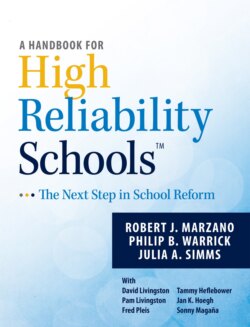Читать книгу A Handbook for High Reliability Schools - Robert J Marzano - Страница 6
На сайте Литреса книга снята с продажи.
Introduction
ОглавлениеUshering in the New Era of School Reform
In industries where mistakes and errors lead to significant and far-reaching consequences—such as nuclear power plants, air traffic control towers, and electrical power grids—organizations must adjust their operations to proactively prevent failure. G. Thomas Bellamy, Lindy Crawford, Laura Marshall, and Gail Coulter (2005) reviewed the literature on these high reliability organizations (HROs) and explained that “what distinguishes HROs is not the absence of errors but the ability to contain their effects so they do not escalate into significant failures” (p. 385). Bellamy and his colleagues further commented,
The literature on HROs describes how organizations operate when accidents or failures are simply too significant to be tolerated, where failures make headlines …. The study of HROs has evolved through empirical investigation of catastrophic accidents, near misses, and organizations that succeed despite very trying and dangerous circumstances. Launched by Perrow’s (1984) analysis of the nuclear accident at Three Mile Island, the literature evolved through discussions of whether such accidents are inevitable, as Perrow suggested, or might be avoided through strategies used by organizations that operate successfully in high-risk conditions (Bierly & Spender, 1995; Roberts, 1990). (p. 385)
Karl Weick, Kathleen Sutcliffe, and David Obstfeld (1999) described HROs as organizations that “take a variety of extraordinary steps in pursuit of error-free performance” (p. 84). More recently, Weick and Sutcliffe (2007) observed that “HROs work hard to anticipate and specify significant mistakes that they don’t want to make. Ongoing attention to these potentially significant failures is built into their practices” (p. 53). These organizations have instituted systems, procedures, and processes that allow them to minimize failures and quickly address or remedy them if they do occur. In other words, the public can rely on these organizations not to make mistakes and to resolve them quickly when they do occur.
Schools are not typically thought of as high reliability organizations. However, nothing prevents a school from becoming an organization that takes proactive steps to prevent failure and ensure success.
